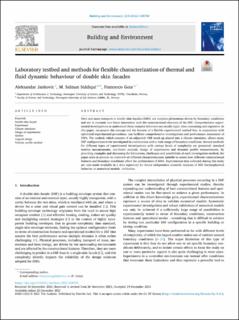| dc.contributor.author | Jankovic, Aleksandar | |
| dc.contributor.author | Siddiqui, Muhammad Salman | |
| dc.contributor.author | Goia, Francesco | |
| dc.date.accessioned | 2022-03-25T07:51:28Z | |
| dc.date.available | 2022-03-25T07:51:28Z | |
| dc.date.created | 2022-01-04T09:12:08Z | |
| dc.date.issued | 2021 | |
| dc.identifier.issn | 0360-1323 | |
| dc.identifier.uri | https://hdl.handle.net/11250/2987522 | |
| dc.description.abstract | Heat and mass transport in double skin façades (DSFs) are complex phenomena driven by boundary conditions and are in constant non-linear interaction with the constructional elements of the DSF. Comprehensive experimental investigations to understand these complex behaviors are usually rigid, time-consuming and expensive. In this paper, we present the concept and the features of a flexible experimental testbed that, in conjunction with optimized experimental procedures, can facilitate comprehensive investigations and performance assessment of DSFs. The testbed, which consists of an adjustable DSF mock-up placed into a climate simulator, allows many DSF configurations to be investigated in combination with a wide range of boundary conditions. Several methods for different types of experimental investigations with various levels of complexity are presented: standard metrics measurements, one-factor analysis, design of experiments and dynamic profile measurements. By providing examples and discussing the limitations, challenges and possibilities of each investigation method, the paper aims to provide an overview of different characterizations suitable to assess how different constructional features and boundary conditions affect the performance of DSFs. Experimental data collected during this study are also made available in a data repository for future independent scientific analyses of DSF thermophysical behavior or numerical models’ validation. | en_US |
| dc.language.iso | eng | en_US |
| dc.publisher | Elsevier | en_US |
| dc.rights | Navngivelse 4.0 Internasjonal | * |
| dc.rights.uri | http://creativecommons.org/licenses/by/4.0/deed.no | * |
| dc.title | Laboratory testbed and methods for flexible characterization of thermal and fluid dynamic behaviour of double skin facades | en_US |
| dc.type | Peer reviewed | en_US |
| dc.type | Journal article | en_US |
| dc.description.version | publishedVersion | en_US |
| dc.source.volume | 210 | en_US |
| dc.source.journal | Building and Environment | en_US |
| dc.identifier.doi | 10.1016/j.buildenv.2021.108700 | |
| dc.identifier.cristin | 1974040 | |
| dc.relation.project | Norges forskningsråd: 262198 | en_US |
| cristin.ispublished | true | |
| cristin.fulltext | original | |
| cristin.qualitycode | 2 | |

